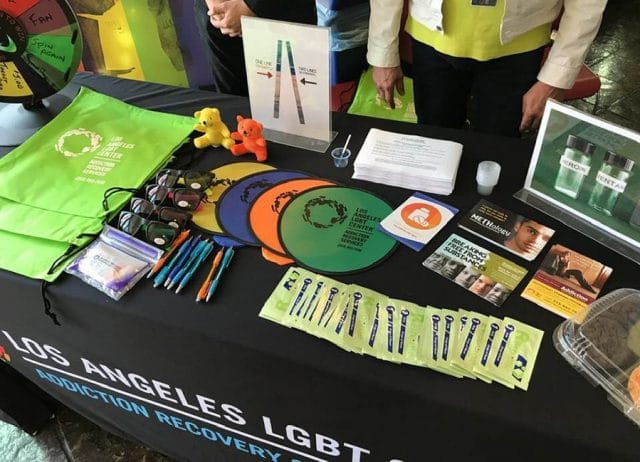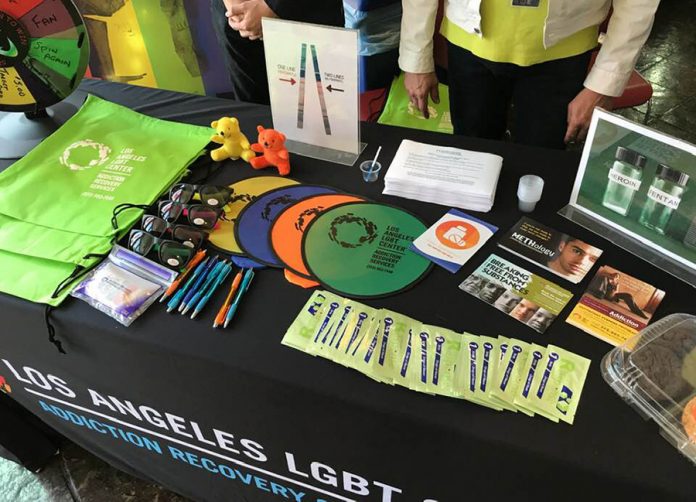
 Facebook Screen Grab
Facebook Screen GrabWeHo Times contributor Albert Serna Jr sat with Manager of Addiction and Recovery Services, at Los Angeles Gay & Lesbian Center, Mike Rizzo, to discuss The Center’s efforts to promote the use of fentanyl testing strips and the impact they have on the LGBTQ community with pride season fast approaching.
At a regular council meeting in April, the city of West Hollywood voted unanimously to fund fentanyl testing strips for the LA LGBT Center in an attempt to prevent more overdoses of the deadly opiate.
 Mike Rizzo
Mike Rizzo
WeHo Times: Mike, thanks for taking the time to speak with me. Can you tell us how long you have been at the center and some more about your department?
Rizzo: I’ve been here at the center for 12 years and originally, we were exclusively crystal meth recovery services. And as that grew, we decided that we would expand, and crystal meth recovery services were no longer appropriate because we were doing other substances as well. It’s kind of a sub department.
In your time here, what have you noticed as far as the rates of crystal meth use in WeHo or by your clients?
So, 40 percent of our clients in mental health have a substance abuse diagnosis. Our top four drugs are Crystal meth, Alcohol, nicotine and then Marijuana. I am often surprised when I get calls from media asking me ‘can you talk about the resurgence of crystal meth in the gay community,’ and my response is, ‘What resurgence? It never went away.’ I think part of the problem; well, drugs can be cyclical if you think about it. In the 60s it was pot, LSD, and in the 70s, we continued with that. The 80s were about cocaine, and then the 90s, meth sort of showed up and now we’re dealing with an opium problem. The opiates are not a big problem in the gay community. Only about six percent of our clients here at The center have been identified with an opiate diagnosis. So, there was a drop a Crystal Meth use in L.A. county and I think that the perception was that things are better, making headways with that and so people moved away from that. L.A. county is broken into what we call service provider areas, or SPAs, and when you look at the numbers overall there has been a drop in Crystal meth use with the exception of two SPAs. That would be SPA seven, which is the Latino community and SPA four which is West Hollywood, Hollywood, Silverlake, Loz Feliz; primarily the gay community. That makes it difficult because there is not a lot of focus on it and again, a lot of the funding is for opiate use. Those are kind of the trends we are seeing in regard to crystal meth use. It’s still 80-90 percent of the clients in our programs are dealing with Meth.
At point did the deadly use of fentanyl get in your radar?
It was not on our radar until last year, and last year we lost one of our employees to an accidental overdose of fentanyl that was cut into the cocaine that they were using. Gilbert [Valenzuela] was not an addict. They were celebrating someone’s birthday, and they were casual users. I think that’s really one of the more startling things for me, is that again, they weren’t using opiates. There is a percentage of people that use fentanyl as their drug of choice, but that wasn’t what had happened. They weren’t aware that there was fentanyl in the drugs that they were using. When that was sort of reported, or it was sort of like said that they think that died of an overdose of fentanyl and like what’s that? So, I started looking it up and it really became quite startling for me and the primary thing is that the people don’t know that it’s in there.
What’s the biggest danger about Fentanyl?
Fentanyl is 100 times more potent than heroin. Individuals may not know they are using it. The normal dose of Narcan, which is the medication that will stop an opioid overdose, may not be affective. You kind of need twice the dosage. And the other thing that’s really important to mention here that I think that [West Hollywood Council Member John Duran] mentioned the other night was that if I’m using a stimulant—usually people tend to use the drug that they like, so that people that use cocaine and meth like to be stimulated, like to be activated, like to be up and aware and that kind of thing. People that use opiates and pot and that kind of thing like to mellow out a bit. So, if I’ve got some cocaine, I’m expecting to be up, and I think people may not know that they are about use an opiate and certainly will not have the intervention tools they may need in case they were to use too much of it. Obviously, the gentlemen that died last year did not have Narcan on them, they wouldn’t have known to have Narcan on them. The important thing to note is that you don’t hear about a lot crystal meth overdoses. It’s usually in combination with another drug. A few years ago, that was GHB, and GHB is still around but nobody overdoses and pure meth.
What is fentanyl normally used for?
It has a medicinal purpose. it’s used for pain relief and certainly when it’s produced by pharmaceutical companies you get a pill. Nobody has that much Fentanyl. It’s mixed with other stuff and is an appropriate dosage. So, Fentanyl that is on the street is just put into it. I can guarantee you the dealer is not a scientist and doesn’t know exactly what he is doing. He’s putting lethal doses of Fentanyl into stuff. It’s fascinating because if first responders feel like Fentanyl is present, they’ll go in wearing hazmat suits because even touching it you can feel the effects of it and even OD on it. So that’s how serious it is.
When did The Center start looking into Fentanyl strips? Was it after your colleague Gilbert died of a fentanyl overdose?
There were a couple of things. In my research, I was finding that although it had been a bigger problem on the East Coast, it was just now hitting the West Coast. Gilbert died in May, right before pride season and I was like wait, there are a lot of casual users that may be using during the Pride season and not knowing that what they’re about to use may kill them. And so, I was really kind of freaked out about that and then somebody in The Center said, ‘Do we have Fentanyl test strips?’ I said no, and I went and looked into it.
When Lorri Jean, our CEO and and Darrel Cummings, our Chief of Staff, reported to the board that this had happened, they were really upset about it, and each of our board members donated $100 for the purchase of the strips. So, we were able to buy 1000 strips immediately with that money.
Then we talked to the county substance abuse prevention and control and they gave us another $5000 to purchase strips and then we had some money in our MAP budget that we spent. So, we initially bought about 7000 strips and during L.A. Pride we probably gave away 2000 of those strips and subsequently gave the rest of them away throughout the center. They are located in every one of our locations; Center WeHo, the Village, they are at the Youth Center. They are located throughout health services, if you go ask for Fentanyl strips in the pharmacy the pharmacist comes out and talks to you about Fentanyl and what that means.
How do the fentanyl testing strips actually work?
As a harm reduction tool, they’re really affective. Basically, what happens is that you take a little bit of your product, you dilute it, you put the strip in…I usually have a couple boxes, but I gave them out. You dilute a little bit of the product and the thing about the Fentanyl test strips is that they are test strips that are used in treatment centers to test people’s urine. People go, ‘oh, do they pee on the stick?’ No, they don’t pee on the stick. What you’re doing is turning your product into liquid, testing it. If there is one red stripe it means that [the product] is positive for Fentanyl and if it is two stripes, it is negative.
These innovations are really great, however for the casual user who is maybe going into a bathroom at a club and is just doing a bump, how do get these people to dilute, test, wait and go, to make sure that they are not taking Fentanyl?
We give the strips before they’ve even bought their stuff and hopefully what they do is test it before they go out. At Pride what we did last year is we purchased those—you know Smart & Final is great—we purchased those little cups where you put condiments in and when we gave the strip out, we also gave them a little cup. If they’re drinking water or whatever they could slip into the port-a-potty and test it there. We gave them everything they needed to test the product immediately if that is what they wanted to do. And certainly, at Pride there are enough discreet areas that they could do that without being noticed.
Does the Center currently have a budget for Fentanyl strips for LA Pride?
We have a medically assisted treatment program which is about using suboxone as an opiate replacement and within that there is a budget for client services. We’ve been able to purchase them through our MAP program, so we do have a budget. Initially we had about 9,000 and we gave those away, and then in January, we purchased another 20,000. The city of West Hollywood approved [$5,000 for fentanyl strips], so what was really interesting and very exciting. They weren’t supposed to vote on it they were just supposed to discuss it. Obviously, something happened in that moment where [West Hollywood Mayor] John D’Amico said ‘wait, wait, wait, let’s just put this on the consent calendar. So, John just moved it immediately to the consent calendar and got it approved… so, we have a supply and I have a feeling we are going to go through those quickly as well because what we’re doing is, we’re going to outreach and we’re going to be available to distribute those strips before each of the pride events that are happening. We’ll be in West Hollywood and we’ll also be here at The Center just tabling and giving out the strips. It’s going to be Long Beach, Los Angeles, San Francisco, San Diego, then we’re going to go into Leather Week in San Francisco in September, Folsom Street, and then Palm Springs in November. We’re not going to be in San Francisco, we don’t have the budget to actually go to these events but what the plan is, is that people here in L.A. can access the strips before they go.
Has there been any backlash from the community or otherwise about providing these Fentanyl strips, any concerns?
The overall response has been really positive, and a lot of people have been like, ‘oh my God I didn’t know about this.’ So not only are we distributing it but we are educating. We’ve had a number of people that have said, ‘you know I have some friends that are using, let me get some of these,’ and have passed them on to their friends. We’ve had even staff members who have gotten strips for their friends and some people have come back and said, ‘I just really need to thank you for this because my friend tested his stuff last night and it tested positive for Fentanyl.’ So as a harm reduction tool we really are saving lives because people can again make that decision.
How has the sober community reacted to these kinds of practices like using Fentanyl strips and harm reduction?
Honestly, I’ll speak from my stand point. I was against harm reduction when I first got sober. I was like, ‘Oh you’re just giving them permission to use and blah blah blah,’ and I was wrong. Very wrong. And then I really started to study harm reduction and really came to the realization that harm reduction can be really useful as the person moves towards abstinence. The reality is that everybody that gets sober goes through a period of harm reduction. They realize they have a problem, I got to tell you very rarely does someone say, “oh I have a problem I need to stop.” They sort of do, ‘ok I’m gonna drink less, I’m gonna use less, I’m only going to use on the weekends, I’ll limit, I’ll use once a month,’ all of that is harm reduction they just don’t label it that way. Harm reduction is just not using less, there’s a lot of things that can fall under the umbrella of harm reduction.
Why not send a message to stop doing drugs, instead of start doing drugs less frequently?
We can either shake our finger at people using drugs and say, ‘Bad. Shame.” You know, all of that stuff. Or we can sort of say ‘Look, we know this is going to happen, so let us help you use safer. Let’s make sure you don’t accidentally OD on this,’ because honestly we’re not going to win the war on drugs. We can have all the DARE campaigns we want, but drugs are going to exist. They’ve existed for centuries and they’re going to continue to exist, but we can win a lot of battles one at a time. For me, as an addiction counselor as well as a therapist, my battles have become one-on-one. If I’ve got a client that’s struggling with substance use, that’s my war at the time. It’s like, ‘How can I help you to stop. And if you’re not going to stop or while you’re trying to stop, if I can help you not die from this, then that’s my battle.’ One of the things that’s really important for me to mention is that with addiction recovery, the success rates, the absolute success rates are not great. Less than 10 percent of people that try to get sober stay sober, and that’s even lower with crystal meth. And so how we measure success from a treatment standpoint is are we lengthening the periods of abstinence and shortening the periods of using. So, if I’ve got a client that sort of uses again every 30 days and is out for a couple weeks. if I can help them get to 60 days and then shorten the period, maybe they’re just out for the weekend and they come back, that’s success and then we build on that. So, “oh my god you got 60 days this time, that’s great lets for 61” and really just try to continue to evaluate what the triggers are why they relapse and then teach them healthier coping skills so they can continue with their abstinence.
For more information on the LA LGBT Center’s distribution of fentanyl testing strips, visit lalgbtcenter.org.







